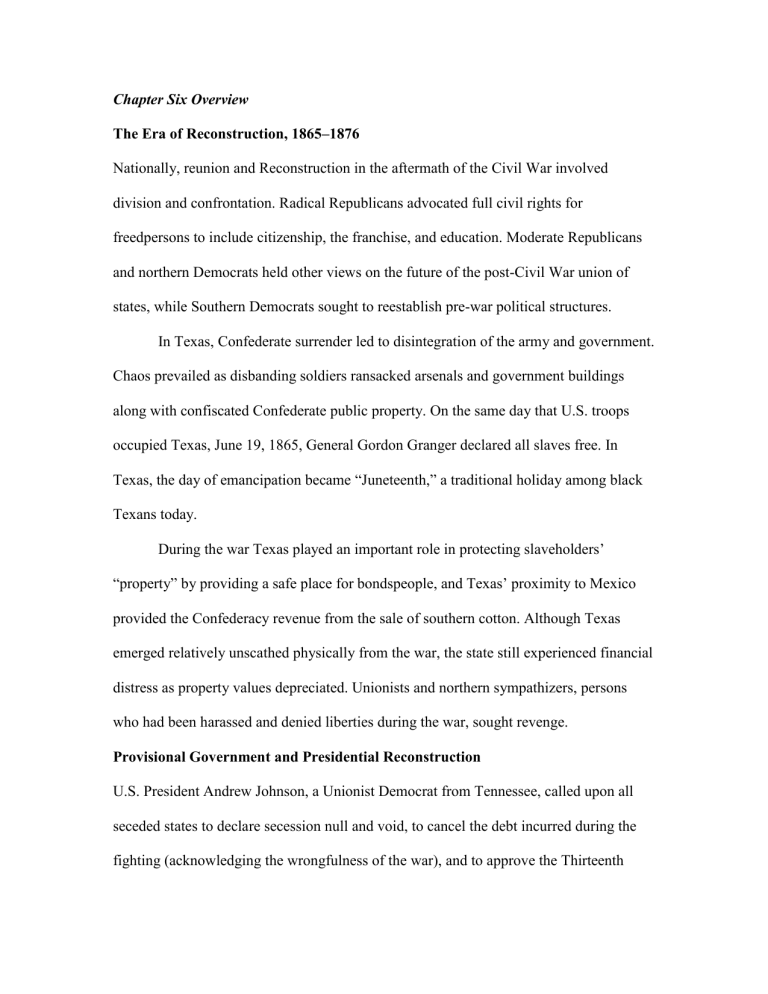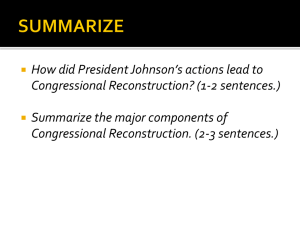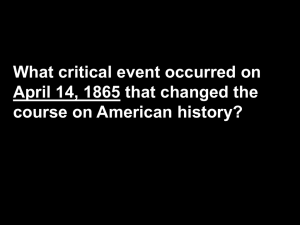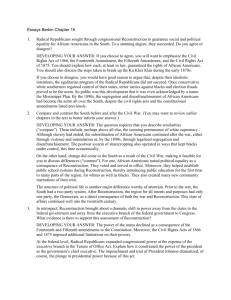Chapter Six Overview The Era of Reconstruction, 1865–1876

Chapter Six Overview
The Era of Reconstruction, 1865–1876
Nationally, reunion and Reconstruction in the aftermath of the Civil War involved division and confrontation. Radical Republicans advocated full civil rights for freedpersons to include citizenship, the franchise, and education. Moderate Republicans and northern Democrats held other views on the future of the post-Civil War union of states, while Southern Democrats sought to reestablish pre-war political structures.
In Texas, Confederate surrender led to disintegration of the army and government.
Chaos prevailed as disbanding soldiers ransacked arsenals and government buildings along with confiscated Confederate public property. On the same day that U.S. troops occupied Texas, June 19, 1865, General Gordon Granger declared all slaves free. In
Texas, the day of emancipation became “Juneteenth,” a traditional holiday among black
Texans today.
During the war Texas played an important role in protecting slaveholders’
“property” by providing a safe place for bondspeople, and Texas’ proximity to Mexico provided the Confederacy revenue from the sale of southern cotton. Although Texas emerged relatively unscathed physically from the war, the state still experienced financial distress as property values depreciated. Unionists and northern sympathizers, persons who had been harassed and denied liberties during the war, sought revenge.
Provisional Government and Presidential Reconstruction
U.S. President Andrew Johnson, a Unionist Democrat from Tennessee, called upon all seceded states to declare secession null and void, to cancel the debt incurred during the fighting (acknowledging the wrongfulness of the war), and to approve the Thirteenth
Amendment ending slavery. The majority of Texans were permitted to assume previous civil rights, but high-ranking former Confederates were ineligible to participate in the restoration of home rule.
Just as the Republican party had been torn asunder, so the Democratic party divided into two distinct factions. At the national level Unionist Democrats resembled congressional Republicans in their support of freedmen civil rights and agreed that the
U.S. Constitution did not permit secession. Conservative Unionists and Conservative
Democrats opposed granting any freedoms to blacks beyond emancipation and continued to defend the states’ right to secede.
Unionist Democrats lost out when James W. Throckmorton, a Conservative
Unionist, was chosen as convention chairperson in Texas. The convention declared secession illegal and repudiated the war debt. Although the convention accepted slavery’s demise, the Thirteen Amendment was not approved by the voters of the state until 1870.
Blacks were denied the franchise and access to public office, jury participation, and access to public schools.
Conservative Democratic leaders worked to limit civil rights for blacks and stood against black equality. Racial tensions mounted in the South with the enactment of “black codes” to maintain social and economic order. In Texas, the Constitution of 1866 further clarified restrictions imposed on freedmen, serving mainly to keep African Americans “as a cheap and controllable labor force.”
Northern Institutions in a Vanquished State, 1865 - 1867
Texans resisted change in the social and economic order; they also resisted the efforts of the Freedmen’s Bureau to aid African Americans in the transition from slavery to
freedom. The Bureau, determined to build administrative centers at the grass-roots level, encountered difficulties and local resistance; by 1870, however, significant strides had been made in the field of education. The bureau also attempted to provide relief and health care, and to rectify grievous instances of injustice. Some bureau agents were inept and disinterested in their work, but the majority of the agents provided “exemplary service in rendering needed assistance to the areas’ black communities.”
Congressional Reconstruction
As Radical Reconstruction began in July 1867, five military districts were created in the former Confederacy. Radical Republicans controlled Congress and passed the
Reconstruction Acts. Congressional Reconstruction demanded that the former
Confederate states draft new constitutions, with all races allowed to participate in selecting delegates to the constitutional conventions. The radicals barred former
Confederate office holders from voting. Historians once interpreted Radical Republican policies supporting complete civil and political rights for African Americans as an excuse to strengthen the Republican party and to neutralize southern racial hostility; today, most scholars support the theory that Radical Republicans did truly desire to bring about a meaningful change in the South.
Republicans in Texas invited black political participation. The most prominent black leader was George T. Ruby, a teacher and traveling agent for the Freedmen’s
Bureau and organizer of local chapters of the Union League. However, violence against
African Americans and intra-party conflict weakened the Republican party. The issue of ab initi o (ultimately decided in the Supreme Court in Texas vs. White , March 1869) aroused contentious debate at the constitutional convention. The Constitution of 1869
granted suffrage and general civil rights to black Texans, extended support for public education, increased the power of the governor, and prohibited land grants for internal improvements.
Only about 4,500 federal troops served in Texas from 1867 to 1870. The soldiers, though stigmatized as outsiders, helped register voters (black and white), protected freedmen and agents from the Ku Klux Klan, enforced martial law, and guarded against
Indians in the western frontier forts.
The 1869 Election and the Davis Administration
Edmund J. Davis, a Radical Republican, was elected governor in December 1869. He supported ab initio and approval of the Thirteenth and Fourteenth Amendments by the seceded states. In the contest for governor Davis barely edged out Andrew J Hamilton, a
Moderate Republican who had fled North during the war. George T. Ruby’s efforts in marshaling the black vote through the efforts of the Union League resulted in over 37,000 blacks casting their ballots in 1869. Once the election results went to the U.S. Congress, a bill restoring Texas to the Union was produced.
The Twelfth Legislature was composed of diverse elements: several Radical
Republicans, Democrats, Moderate Republicans, and two black senators and twelve black representatives. Two prominent black leaders/state senators were George T. Ruby and
Matt Gaines, a self-educated former slave who became a Baptist lay preacher after the
Civil War.
Governor Davis’s top priority was restoring law and order. Other goals included funding a statewide school system for both blacks and whites, subsidizing internal improvements, and increasing frontier protection. Scalawags were prominent in the Davis
administration; and with their support, Davis was able to accomplish the stated goals.
Radical Republicans did not attempt to overturn long-standing economic, political, and social mores. They were not nearly as radical as they had previously been judged.
Black Texans during Reconstruction
Social segregation arose immediately after the war; not — as generally assumed — toward the latter part of the nineteenth century. Social customs imposed social segregation, not legal dictates. Sharecropping kept blacks and whites enslaved to debt.
Poverty diminished opportunities and provided dismal living conditions. Disease was prevalent; and without proper medical attention, mortality rates among blacks, particularly infants, was high.
Blacks sought to strengthen the cohesiveness of their own communities and to protect their cultural autonomy by building their own schools and founding their own religious institutions. While the bureau remained in place, black marriages were legalized, grievances were brought before the bureau courts, and blacks found some redress from Republican district court judges appointed by Governor Davis between 1870 and 1873.
Black Texans pursued every viable form of employment. Black women sought jobs in white households. Some black men found work in East Texas’s burgeoning lumber industry. Others joined the state police or militia in the early 1870s. Some black
Texans managed to found successful businesses or enter professions (such as teaching).
On the West Texas range, a few black men made their mark as cowboys. While white society generally restricted blacks on cattle drives to the roles of cooks or wranglers, black cowboys could well earn respect among fellow drovers
A Perilous Place in Which to Live
Lawlessness and violence dominated the period of Reconstruction through the 1890s.
Historians have tried to explain the violence by citing the bitterness arising out of the
Civil War and Reconstruction but Indian warfare, banditry, racial tension, unrest among agrarians and ranchers, and the unsettling aspects of modernization and a closing frontier were also instigating factors.
Vigilante movements surfaced in a region bounded by Houston, the Hill Country, and the Dallas—Fort Worth area. Some were family feuds while others were community conflicts. The most notorious was the Sutton-Taylor feud stemming from the bitterness of the Civil War. Lynchings by “White cappers” (white racist vigilantes) motivated the
Legislature to pass an anti-lynching law in 1897, but the measure did little to deter racially motivated brutality.
The Indian Displacement
The turmoil of the Civil War era permitted the Comanches to regain control of western territory. The U.S. government responded with a continuation of the policy of displacement. A line of defensive forts was reestablished, but the forts were spaced too far apart to effectively curtail Indian raids. Colonel Ranald Slidell Mackenzie led a new
U.S. Army military offensive that followed the Salt Creek Massacre in 1871. Destruction of Indian pony herds and entire Indian villages had its intended effect—by 1873, the frequency of Comanche raids decreased markedly.
The last remaining Plains Indian tribes lacked farms or an efficient infrastructure to stem the relentless tide of white settlers pushing westward. Disease, alcoholism, and a new reliance on consumer goods acquired from whites eroded traditional skills and
culture, but the most devastating factor was the destruction of the great buffalo herds. By the 1880s the Indian peoples were destitute with no other choice but to relinquish their independence.
The Rise of the Cattle Kingdom
The Texas Cattle Kingdom era began as the Civil War drew to a close and lasted until the mid-1880s. Once new stock restored the war-depleted herds in the North, the price of beef skyrocketed. The Chisholm Trail, the Great Western Trail, and the Goodnight-
Loving Trail were marked and posted. By the late 1870s, “land and cattle companies” dominated more than half the rangeland and livestock in the South Plains and Panhandle.
Even so, Texas cattle drives did not stand the test of time. Severe winters and extended droughts in the mid-1800s dealt the final blow, with barbed-wire becoming the symbol of the modern cattle industry.
“Redemption”
Edmund J. Davis did much to strengthen the state’s economy and social infrastructure.
During the gubernatorial race in 1873, Davis campaigned on the programs that he had initiated in office. Richard Coke, an ex-Confederate, ran on the promise of “redemption”
— to “redeem” Texas from Republican rule, to restore strong states’ rights, and to overthrow the coalition of Republicans and freedmen. Coke appealed to business interests, endorsing railroad and industrial expansion while winning the support of the
Patrons of Husbandry (the Grange). Coke’s Redeemers blamed the Republicans for the agricultural depression of 1870. As Davis prepared to transfer his office to Coke, the election was declared illegal on January 5, 1874, by the Texas Supreme Court in the case of ex parte Rodriguez.
While Coke and the Democrats pursued plans to take over the
government immediately, Davis wired President Ulysses S. Grant. By the time Davis received Grant’s non-committal reply, Coke had already been sworn in as governor —
Reconstruction was dead in Texas.
Constitution of 1876
Hoping to eliminate all traces of Reconstruction and overturn Republican successes on behalf of blacks, conservative Democrats demanded a new constitution aimed at restoring states’ rights. In 1875 Coke called for a constitutional convention. The new Constitution of 1876 included provisions that prohibited the state from chartering banks, empowered the state to regulate corporations and railroad companies, established a state debt ceiling of $200,000, placed a strict limit on the maximum ad valorem tax rate, and weakened the public school system. The convention also chose biennial rather than annual legislative sessions and concluded its business by striking down a poll tax, repudiating voter registration, and denying women the vote.
Both Grangers and conservative Democrats opposed compulsory school attendance and the property tax if it meant using tax money to educate black children.
The convention did, however, mandate segregated schools; and in a positive sign for the future, endowed a permanent school fund with revenue from the public domain. The new constitution was approved by the electorate in a better than two-to-one margin. Although never considered a remarkable document, the Constitution of 1876 still serves presentday Texas. Two serious attempts to write a new and more modern constitution have been vetoed.
Chapter Six Learning Outcomes
Upon completion of studying this chapter, you will be able to:
understand the Reconstruction process that Texas and other southern states experienced,
comprehend the political changes that Reconstruction wrought in Texas,
cite key differences in political philosophies between the Republican and
Democratic parties,
recognize the implications of Emancipation and Reconstruction on the lives of a newly-freed people,
understand the factors contributing to the violence and lawlessness that gripped
Texas during Reconstruction through the 1890s.
Chapter Six Key Words and Terms
“Radical Republican”
“Juneteenth”
Presidential Reconstruction
Congressional Reconstruction
Freedmen's Bureau
ab initio
Ku Klux Klan in Texas
Union League
Texas v. White
Constitution of 1876
George T. Ruby
Matt Gaines
“scalawags”/”carpetbaggers”
Constitution of 1869
Edmund J. Davis
Walter Prescott Webb
Forts Concho, McKavett, Belknap, and Griffin
Cynthia Ann Parker
Quanah Parker
Comanche range
Salt Creek Massacre
Col. Ranald Slidell MacKenzie
Battle of Adobe Walls
Battle of Palo Duro Canyon
Goodnight/Loving Trail
Chapter Six Links
Texas State Library and Archives Commission provides this web page entitled
“
Portraits of Texas Governors: War, Ruin and Reconstruction
” with biographies and primary sources for the gubernatorial era, 1866 to 1876.
Texas State Library and Archives Commission provides this web page entitled “ The
1860s: Reconstruction
” and “
The 1870s: Representation
” with biographies of the ten
African Americans who were elected to serve in the 1868-69 constitutional convention that included George T. Ruby and Matthew Gaines. Links also to
Freedmen’s Bureau and Union League as well as the constitutional convention of
1875.
“
The World Turned Upside Down: Reconstruction in Texas
” — includes various discussions: The Myth vs. the Reality of Reconstruction, Wartime Reconstruction,
Postwar Reconstruction, Congressional Reconstruction, Undoing Reconstruction, and
Enduring Impacts of Reconstruction in Texas.
The U.S. Army on the Texas Frontier — Texas Forts (images, maps and text).







